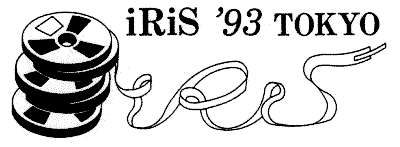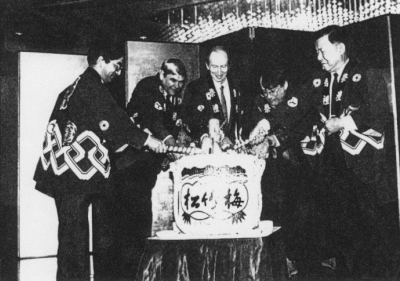The iRiS '93 Tokyo Workshop was held at CRL


At the IRIS Steering Committee held during the XX th IUGG General Assembly in Vienna in 1991, the workshop on VLBI in 1993 was suggested by Dr.W.Carter as a Coordinator of VLBI in IERS. Since the Science and Technology Agency in Japan approved the budget for the workshop, the Communications Research Laboratory hosted the iRiS '93 TOKYO (International Workshop for Reference Frame Establishment and Technical Development in Space Geodesy). It was also supported by the Geodetic Society of Japan.
In the workshop, 111 participants came from 9 countries including 28 researchers from foreign countries. In total, 64 papers were given including 4 poster contributions. In the plenary meeting after all the sessions, the concluding discussion was made.
The regular TDC meeting to have been in February 1993 was canceled because of the workshop and CSTG IRIS committee.
Program of the workshop
| (1) | Opening |
| (2) | Review Session |
| (3) | Technical Development Center |
| (4) | VLBI Technology |
| (5) | Laser Ranging and reference frame |
| (6) | GPS and reference frame |
| (7) | Terrestrial reference frame |
| --- Banquet --- | |
| (8) | Regional VLBI network |
| (9) | Southern hemisphere |
| (10) | Time and earth rotation parameter |
| (11) | Celestial reference frame |
| (12) | IERS Standards |
| (13) | Plenary meeting for concluding discussion |
| (14) | Closing |
| Previous Mtg: | Vienna, IUGG General Assembly | |
| Participants: | Thomas Clark | (NASA/GSFC) |
| Dennis McCarthy | (USNO) | |
| Arthur Niell | (Haystack Observatory) | |
| Bob E. Schutz | (CSR/Texas Univ.) | |
| James Campbell | (Bonn Univ.) | |
| Ye Shuhua | (Shanghai Observatory) | |
| David Jauncey | (COSSA) | |
| Peter MuCulloch | (Tasmania Univ.) | |
| Zuheir Altamimi | (IGN) | |
| Koichi Yokoyama | (NAO/Mizusawa) | |
| Daniel Rosenblatt | (Guest Scientist in NIED) | |
| Taizoh Yoshino | (CRL) | |
| Michito Imae | (CRL/Kashima) | |
| Shin'ichi Hama | (CRL/Kashima) | |
| Yukio Takahashi | (CRL/Kashima) | |
| Kosuke Heki | (CRL/Kashima) | |
| Bret Engelkemier | (Guest Scientist in CRL) | |
| Agenda | |
| 1. | Opening T. Yoshino. CRL |
| 2. | Regional Reports |
| 3. | IERS Technical Development Reports |
|
Conclusions
The large number of substantial contributions presented by members of the different Japanese institutions involved in VLBI clearly expresses the strong commitment of the Japanese scientific community to use and further develop this technique for the benefit of astronomy, geodesy and geodynamics. In addition, participants from other parts of the world added their input on related topics, reflecting the close cooperation that exist between the Japanese and the international research groups concerned with VLBI.
Only a choice of some of the items of special interest can be mentioned here:
1. Technical developments
At present, several VLBI data recording and correlation systems are in use and under development. Among these a first production model of the Japanese K4-system recorder and correlator (one baseline) was on display. On the side of the MkIII/MkIV-systems the plans for a considerable bandwidth upgrade as well as an increase of recording density of two orders of magnitude were presented. In the discussions, the question of lack of compatibility between the systems raised great concern, because, in principle, VLBI requires observations between all available stations for both astronomy and geodesy in order to exploit the full information content provided by this technique.
In the final plenary discussion of the workshop it was decided that the IRIS subcommission set up a working group to produce a memo on a possible solution to the compatibility problem. The working group will consist mainly of the individuals directly concerned with the technical side and start by facilitating the information exchange between the different groups involved.
The solution to the problem of compatibility may be to define a common interface between the different playback units and the correlator in order to be able to handle different inputs with the same correlator. Such a solution should not preclude further developments towards much higher data rates and recording densities.
In conjunction with the main item of VLBI recording and correlation systems, a number of interesting new technical developments were presented, such as antenna cluster observations, lunar transmitters for delta-VLBI, space-VLBI, a fiber-optics link and portable VLBI antennas.
2. Systematic effects in VLBI observations
Several contributions dealt with the path delays in the atmosphere, but while in earlier meetings the wet part of the neutral atmosphere was most prominent, this time the need for improved mapping functions of the dry part was stressed. Mismodelling can introduce baseline length changes and may distort global networks by several centimeters. The vertical component of the positions suffer 3 to 6 times more from atmospheric modeling errors than the horizontal components.
Several contributions discussed the effects of the ionosphere, both in terms of a nuisance effect as well as in view of providing information for monitoring the ionosphere.
3. Plate tectonics
Results from measurement series of more than eight years are yielding highly precise baseline rates which can be compared to plate motion models derived from geophysical data. The emphasis is now turning to those sites near the plate boundaries, where large discrepancies have been revealed and need to be explained, such as in California, Alaska, Japan and eastern China.
The regional VLBI networks in Japan and in Europe, which became operational only a few years ago, are already showing the first signs of tectonically significant site motions.
4. Reference frames
A large section of the meeting was concerned with reference frames, both celestial and terrestrial. The lack of uniform coverage at both levels became apparent in the southern hemisphere, although ongoing campaigns are busy to close this deficit. The fact that several new stations are coming up and are in the planning in South America (Santiago and Fortaleza) and on the continent of Antarctica (O'Higgins, Syowa and McMurdo) demonstrates the growing interest in using VLBI for astronomical and geodynamical research in the southern hemisphere.
The importance of the VLBI contributions to the ITRF became apparent in many global solutions and it was recommended to use the most recent ITRF-solutions when tying regional nets to the global frame.
The increasing share of GPS in the establishment of the terrestrial reference frame was highlighted by contributions about regional networks in the western Pacific. In this respect, the suggestion to structure the different levels of ties between the networks by using the concept of GRL (Global/Regional/Local) was seen as very useful.
5. Postglacial Uplift
In view of the difficulties to achieve high accuracy in the vertical component of positions due to atmospheric delays, it was important to note that the smaller horizontal motions associated with the postglacial uplift phenomenon might be easier to detect, because of the high accuracy of the baseline lengths derived from the VLBI measurements.
6. Antarctic stations
Both the successes and the disappointments associated with the first attempts to achieve geodetic ties with the continent of Antarctica were demonstrated in the contributions on the new stations of Syowa (Japan) and O'Higgins (Germany). While the German station is scheduled to be manned at least twice per year and will participate in the southern VLBI campaigns, the station of Syowa and the planned station of McMurdo (USA) have received no firm commitment yet to be operational for VLBI in the future. In view of the tectonically unstable location of O'Higgins it will be very important to have the two other sites included in the network, in order to be able to determine the plate motions of Antarctica.
In a more general context it was pointed out that the commitment to regular observing campaigns should not lag behind the technical developments.
J. Campbell
T. Yoshino
T. Sasao
Possible solutions will be further discussed at the VLBI conference in Kyoto, Sept.6-10, 1993.
